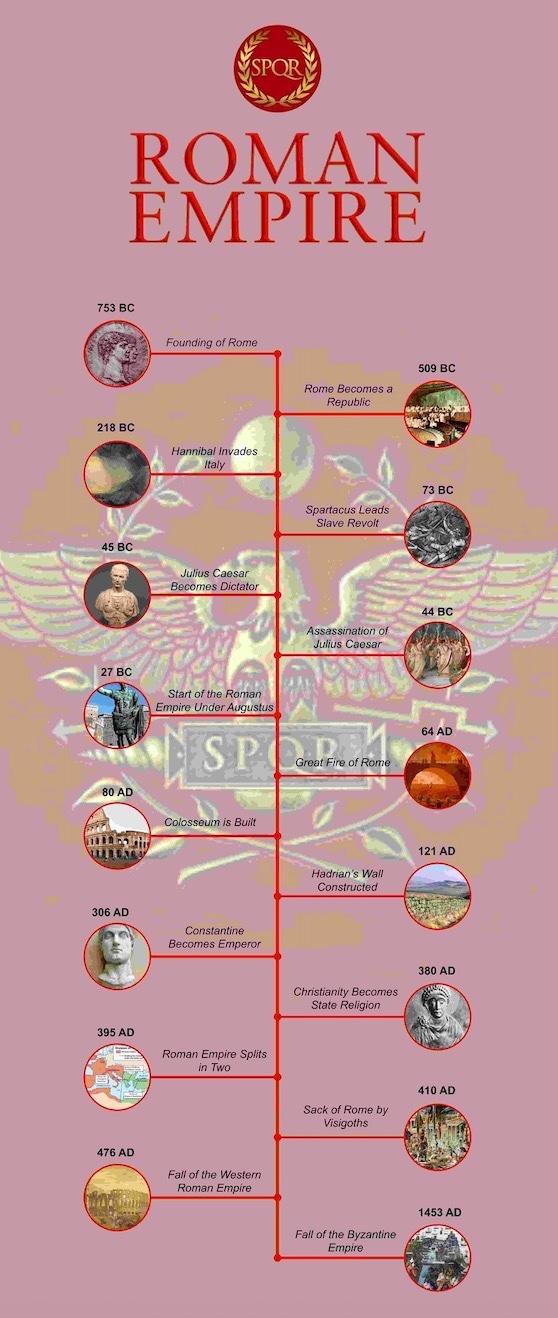The Roman Empire began as a small city on the banks of the Tiber River. Founded in 753 BC, it grew into one of the most powerful and influential empires the world has ever seen. Its rule stretched from the misty shores of Britain to the deserts of Egypt.
For more than 1,000 years, Rome shaped history. Its armies marched, its rulers commanded, and its culture flourished. Even after the empire fell, its ideas, roads, and buildings lived on.
This timeline takes you through Rome’s journey. From its birth to its end, every event left its mark.
In this article
The Roman Empire Timeline
The story of Ancient Rome is told in three main parts. It began with the Roman Kingdom, from 753 to 509 BC. Then came the Roman Republic, lasting from 509 to 27 BC. After that, the Roman Empire rose, ruling from 27 BC to 476 AD in the West, and until 1453 AD in the East, known as the Byzantine Empire.
Rome’s history is full of action. It saw great conquests, clever leaders, and powerful armies. But it also faced wars, political rivalries, and invasions. So, let’s explore the key events that shaped Rome’s incredible journey.
753 BC: Founding of Rome
Legend says Rome began when twin brothers Romulus and Remus were raised by a she-wolf. Later, Romulus became the first king after a fight between the brothers. The story mixes myth and history, but it’s one of the most famous beginnings in the world.
From a small group of huts on the Palatine Hill, Rome started its journey. It would grow from this tiny settlement into one of the greatest empires in history.
509 BC: Rome Becomes a Republic
Tired of kings, the Romans overthrew Tarquin the Proud. They swore never to have a king again. Instead, they created a republic where two consuls shared power, and the Senate advised on laws.
Only certain citizens could vote, but it was a bold experiment. This new system encouraged debate and civic duty. It became the foundation of Roman politics and inspired governments for centuries to come.
218 BC: Hannibal Invades Italy
Hannibal, a Carthaginian general, pulled off one of history’s boldest moves. He marched his army and elephants across the freezing Alps to attack Rome from the north. His daring plan worked.
He crushed Roman forces in several battles, including the famous Battle of Cannae. For years, he roamed Italy, terrifying the Romans. But he never captured the city itself. His campaign remains legendary in military history.
73 BC: Spartacus Leads Slave Revolt
Spartacus, a gladiator, escaped a brutal training school with a small group of slaves. Their rebellion grew into an army of tens of thousands, defeating Roman forces again and again.
For two years, they challenged Rome’s power. The revolt spread fear through the republic. Eventually, Spartacus was killed, and his army was destroyed. His name still stands as a symbol of courage against oppression and injustice.
45 BC: Julius Caesar Becomes Dictator
After years of civil war, Julius Caesar defeated his rivals and claimed power. Declared dictator for life, he introduced reforms, improved the calendar, and gave citizenship to more people.
Many praised him as a visionary leader. But others feared he wanted to be king, ending the republic forever. This fear would soon lead to betrayal, murder, and a turning point in Roman history.
44 BC: Assassination of Julius Caesar
On March 15, the Ides of March, Caesar entered the Senate. Senators surrounded him, and even his friend Brutus joined in the attack. They stabbed him twenty-three times.
The plotters believed they were saving the republic. Instead, they threw Rome into more chaos and civil war. Caesar’s death cleared the way for his heir, Octavian, to rise as the first emperor.
27 BC: Start of the Roman Empire Under Augustus
Octavian defeated Mark Antony and Cleopatra, taking full control of Rome. Renamed Augustus, he became the first emperor. His reign ended decades of civil war and began the Pax Romana, a time of peace and prosperity.
Augustus strengthened borders, reformed laws, and encouraged art. He ruled wisely and carefully balanced power. His leadership shaped the empire’s future for generations and secured his place in history.
64 AD: Great Fire of Rome
A huge fire broke out for six days, destroying much of Rome. Homes, temples, and public buildings were gone. Thousands were left homeless and desperate.
Rumors spread that Emperor Nero ignored the flames or even started them, though no proof exists. He blamed Christians, sparking persecution. The city’s rebuilding brought grander structures and better safety, changing Rome’s look forever.
80 AD: Colosseum is Built
The Colosseum opened with spectacular games lasting 100 days. Gladiators fought, wild animals clashed, and even mock sea battles thrilled the crowd. The arena could hold 50,000 people.
It became a symbol of Roman engineering and entertainment. Today, its ruins still inspire awe. The Colosseum tells stories of power, spectacle, and the Roman love for grand public events.
121 AD: Hadrian’s Wall Constructed
Emperor Hadrian built a massive wall across northern Britain to protect against tribes. It stretched over 70 miles, with forts, towers, and gates. Soldiers guarded the border day and night.
The wall marked the empire’s northern edge. It showed Rome’s control over distant lands. Today, parts still stand, reminding us of Rome’s reach and its determination to defend its frontiers.
306 AD: Constantine Becomes Emperor
Constantine rose to power during turbulent times. He is famous for ending the persecution of Christians and granting freedom of worship through the Edict of Milan.
He founded Constantinople as a new capital. The city was perfectly placed for trade and defense. It grew into a major cultural center, keeping his influence alive for centuries after his reign.
380 AD: Christianity Becomes State Religion
Emperor Theodosius made Christianity the official religion of the Roman Empire. Pagan temples closed, and Christian customs became part of daily life.
This decision changed Rome’s culture forever. The Church gained power and influence in politics. Christianity shaped the empire’s values and would guide European history for centuries to come.
395 AD: Roman Empire Splits in Two
In 395 AD, the Roman Empire was officially divided into East and West. The Western Roman Empire was ruled from Rome, and the Eastern from Constantinople.
The split helped manage the vast territory, but it also weakened unity. Over time, the two halves grew apart, facing their own struggles. The East would last for centuries, but the West faced growing threats.
410 AD: Sack of Rome by Visigoths
King Alaric and the Visigoths marched into Rome and looted it for three days. It was the first time in nearly 800 years that a foreign enemy had taken the city.
The event shocked the ancient world. Rome, once thought unbreakable, had fallen to outsiders. It was a sign that the Western Empire’s power was fading fast.
476 AD: Fall of the Western Roman Empire
The last emperor, Romulus Augustulus, was overthrown by Odoacer, a Germanic leader. With no replacement, the Western Roman Empire came to an end.
Europe entered the Middle Ages. But in the East, the Byzantine Empire, the last part of Rome, survived for nearly a thousand more years, keeping Roman traditions alive.
1453 AD: Fall of the Byzantine Empire
In 1453 AD, after a long siege, Ottoman forces under Mehmed II captured Constantinople, the capital of the Byzantine Empire. This was the final chapter of the Roman Empire’s long history.
The fall ended over 1,000 years of Eastern Roman rule. It also marked a turning point in world history, leading to the rise of the Ottoman Empire. Rome’s legacy, however, still shapes the modern world.
How to Make the Roman Empire Timeline in EdrawMax?
The Roman Empire’s story has everything: powerful leaders, epic battles, and unforgettable moments. But all those dates and events can be hard to follow. EdrawMax can make it simple by turning history into a colorful timeline you can read at a glance.
Here’s how to make the Roman Empire timeline in EdrawMax.
Step1Login & Start a New Project
- Download and install EdrawMax on your computer.
- Open the program and log in with your Wondershare ID or linked social account.
- From the left sidebar, click Home, then choose Basic Diagram on the top blue bar.
- Select Timeline to explore ready-made designs, or search “timeline” in the top-right box.
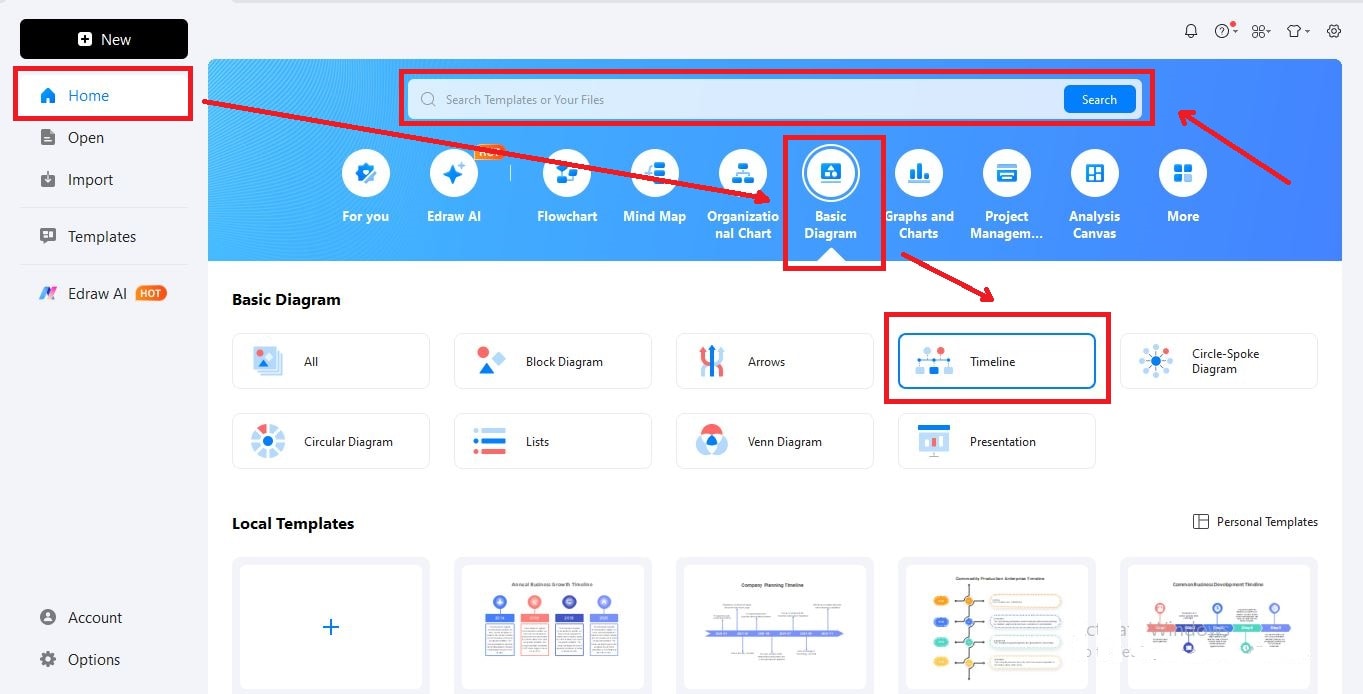
Step2Select a Suitable Template
- In Local Templates, browse different styles, horizontal, vertical, or circular.
- Or scroll more, to find your desired template.
- Pick one for your Roman Empire project. Double-click or click Use Immediately to open your selection
- Click Blank Drawing to start fresh.
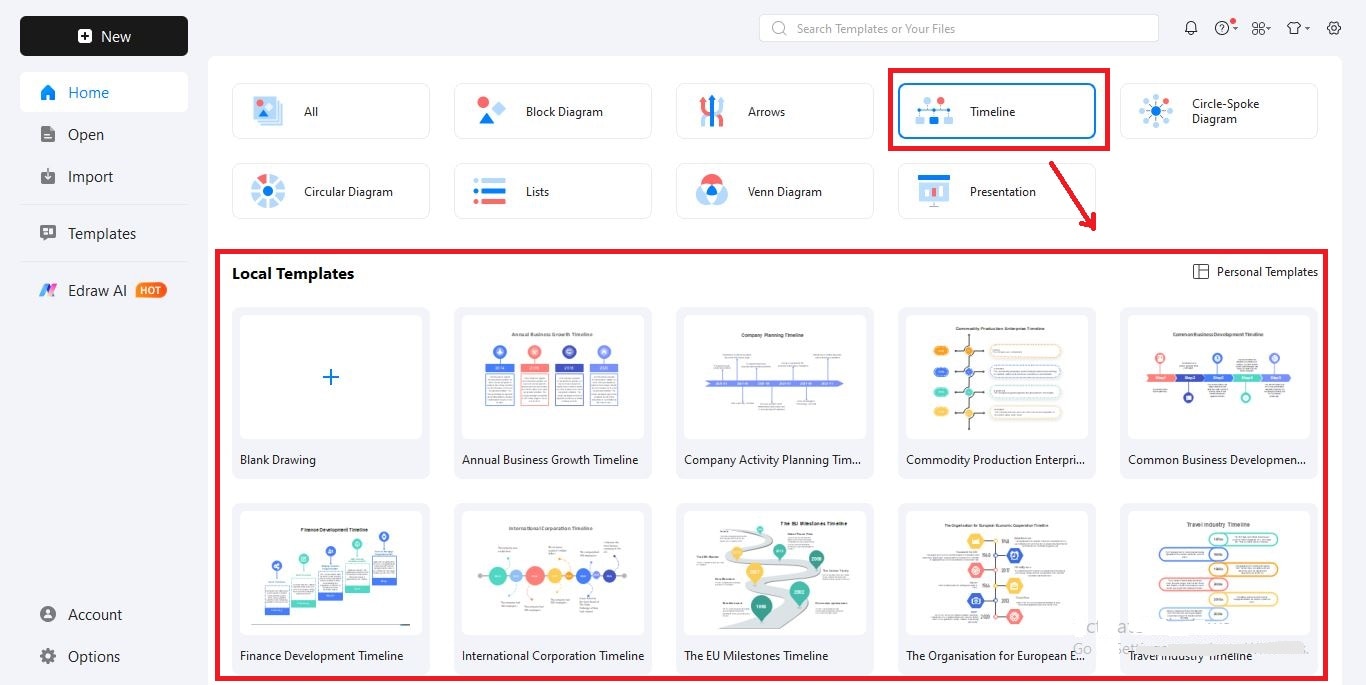
Step3Add a Title and Key Events
- In the Home tab, click Text to add a title like “Roman Empire.”
- Replace sample text with events (e.g., “753 BC: Founding of Rome”).
- Double-click anywhere to add new text.
- Use the floating toolbar to adjust font, size, color, or alignment.
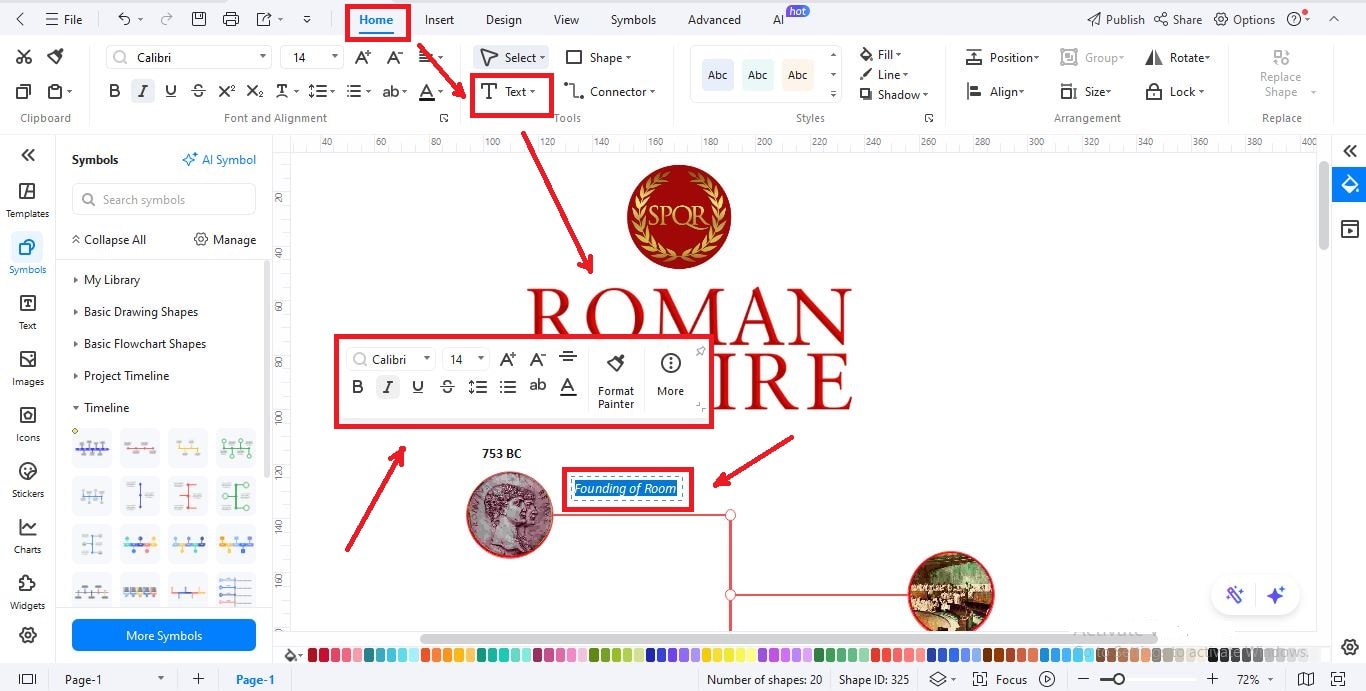
Step4Arrange and Link Historical Moments
From the Home tab:
- Click Select to move items.
- Use Text for new event labels.
- Use Shape to create more boxes for milestones like “44 BCE: Assassination of Julius Caesar.”
- Choose Connector to link related events.
You can also add Roman-themed icons, images, or ancient map symbols from the left toolbar by dragging and dropping.
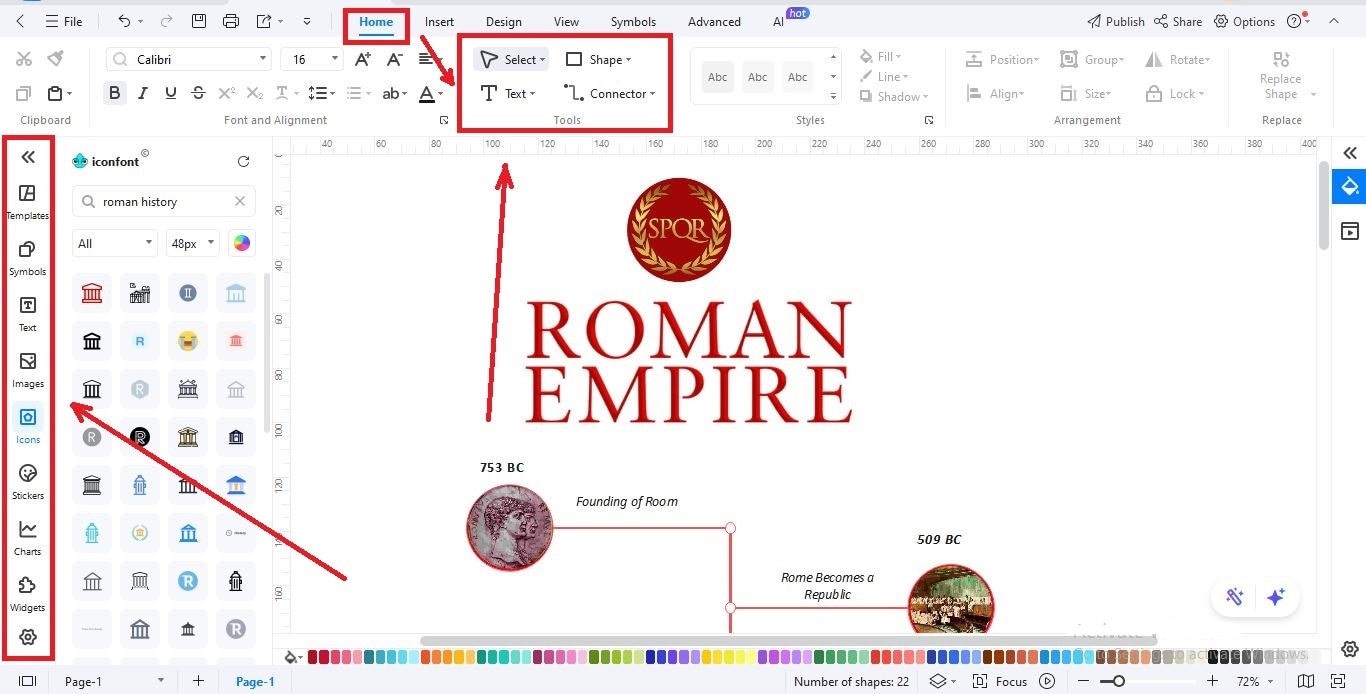
Step5Customize Your Timeline Design
To customize your timeline, select any object and use Styles to adjust Fill, Line, and Shadow.
- In the top-right, use Position, Align, Size, Group, Rotate, and Lock for neat arrangement.
- To add symbols, click the Symbols option in the left side panel, and More Symbols option to find more related symbols.
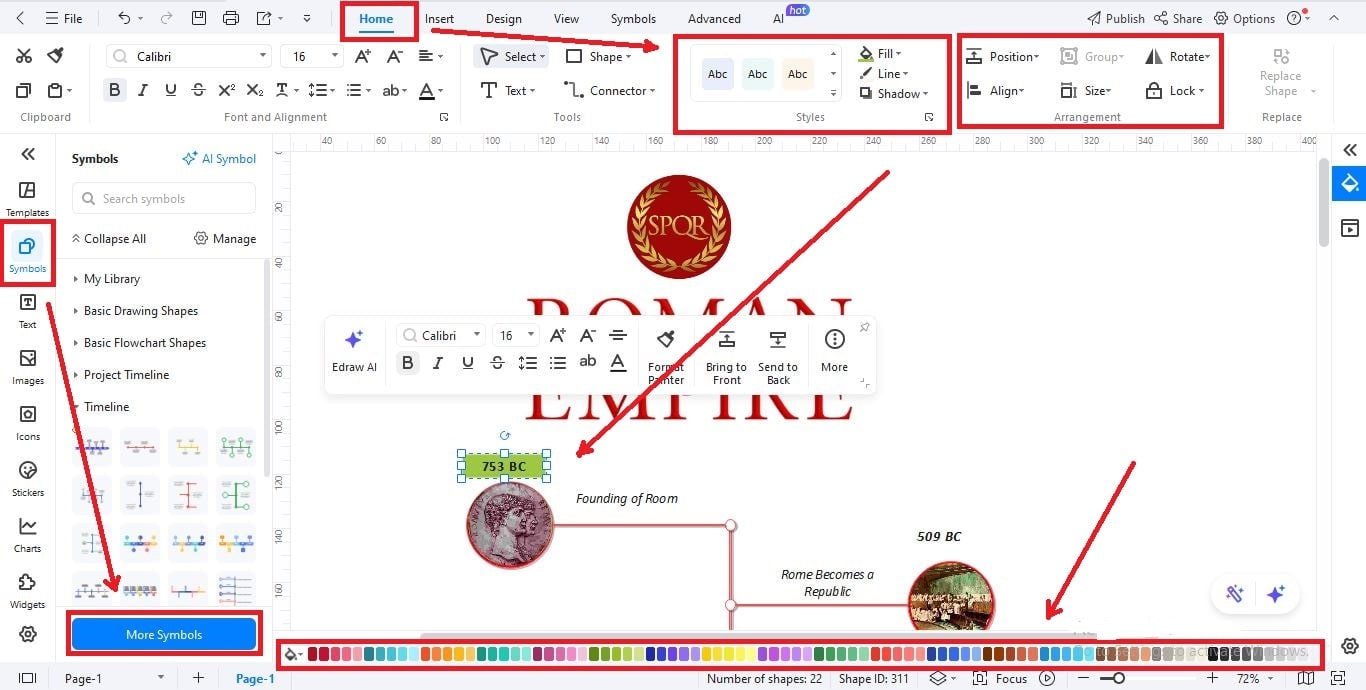
Step6Add a Thematic Background
- Go to Insert > Picture to add a Roman map background.
- From the floating toolbar, choose Send to Back to make it as a background image.
- Adjust transparency from the Adjust option, and lock it with Move to Layer.
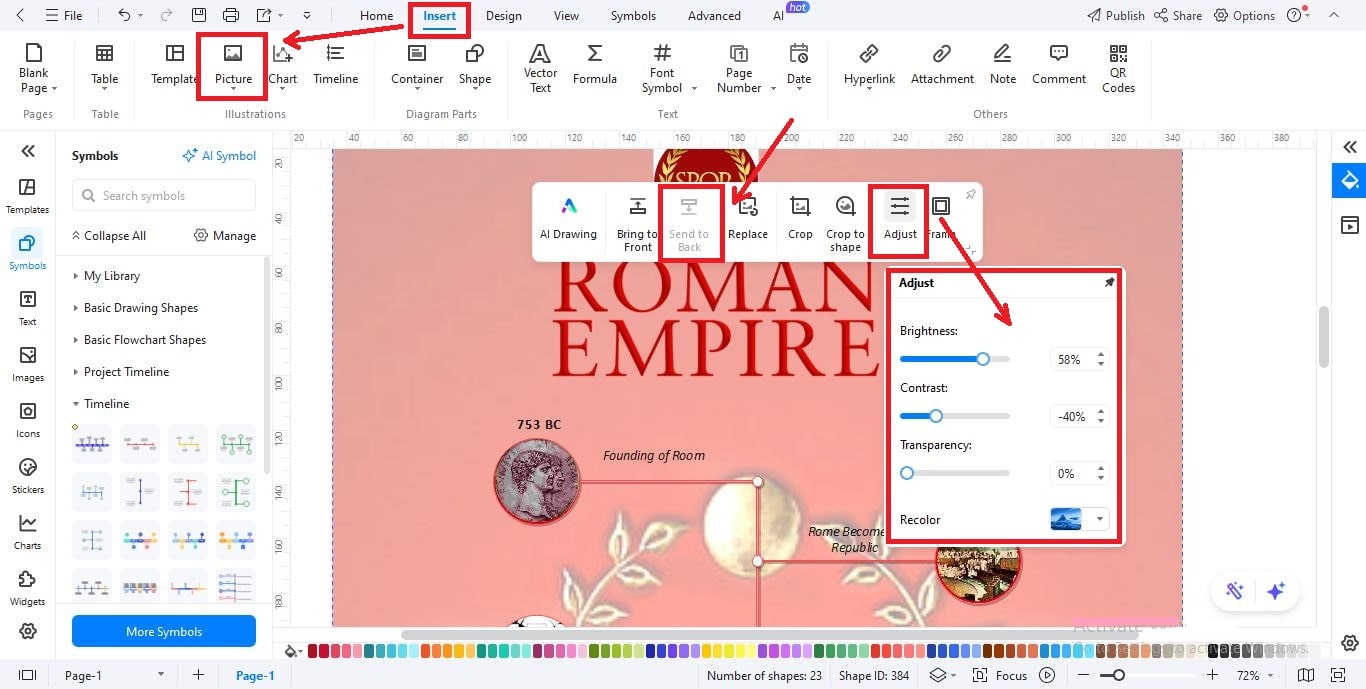
Step7Save, Share, and Export
- From the File menu, click Save to store an editable version.
- Click the Share button to send it to others.
- To export, go to File > Export and choose PNG, PDF, SVG, HTML, Visio, or Excel.
- You can also publish your Roman Empire Timeline to the EdrawMax community for others to view by clicking the Publish button.
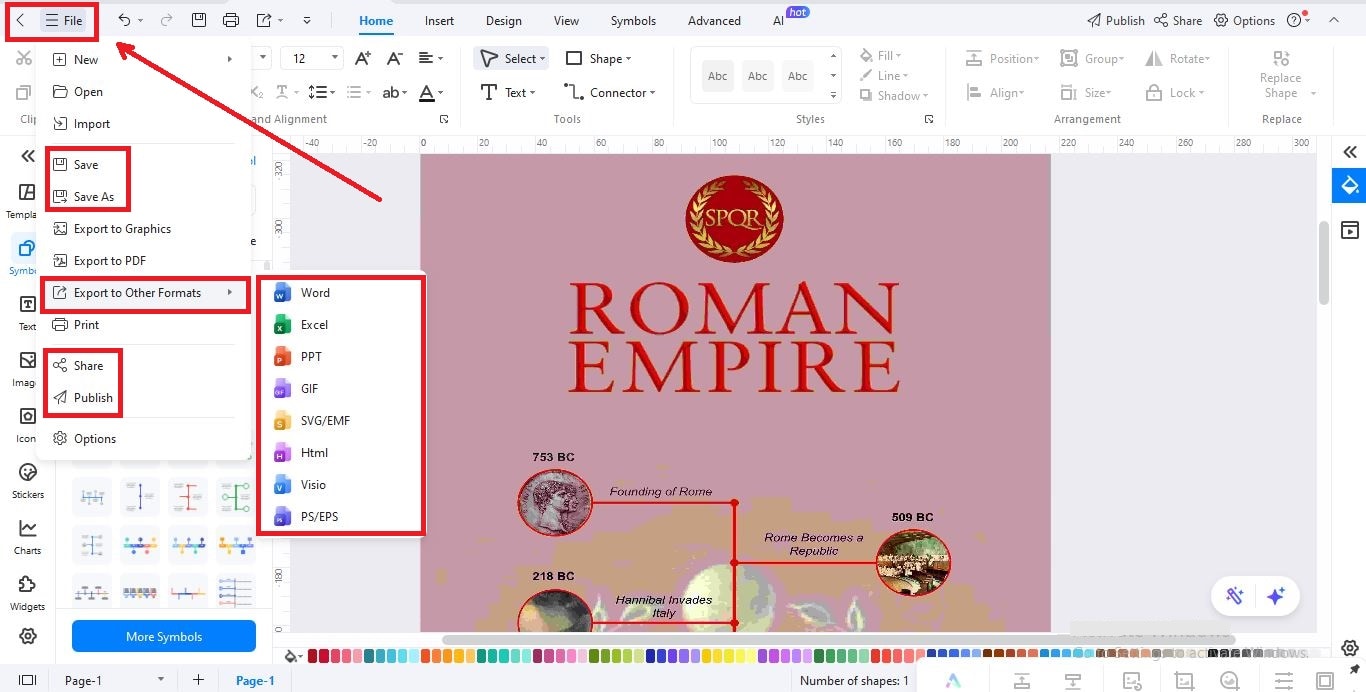
Closing Remarks
Ancient Rome’s past is a story of rise, dominance, and lasting influence. From its mythical origins to its collapse, Rome built an empire through innovation, leadership, and conquest. Every chapter in its history shows strength and transformation. Its legacy still shapes our world today.
If you want to explore it in detail, use EdrawMax to organize and present the Roman Empire’s history clearly. It is an easy-to-use tool perfect for projects, presentations, or personal learning.




